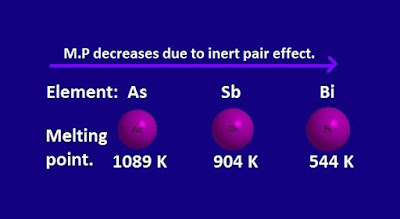Inert pair effect-definition-examples-cause-and consequences
·
Inert pair effect definition in chemistry
Inert pair effect is generally exhibited by the P-block elements. There are some
heavier P-block elements,[ Such as, Sn, Pb, Sb, Bi etc ] with molecular formula ns2 np1-6 , have a less tendency to leave their outer most S-electrons easily.
That is, the electron present in the outer most S-orbital , does not participate in the formation of a chemical bond.
The
tendency of this electron pair to stayed inert, is called inert pair effect.
·
Examples of Inert pair effect in chemistry
Somep-block elements, such as tin ( Sn ),
lead(Pb), bismuth ( Bi ) etc exhibit
Inert pair effect . The ‘5s’ electron of tin and ‘6s’ electrons of lead and bismuth have a tendency to main inert due to inert pair effect.
Inert pair effect . The ‘5s’ electron of tin and ‘6s’ electrons of lead and bismuth have a tendency to main inert due to inert pair effect.
·
Cause of Inert pair effect in chemistry
There
are some p-block elements, such as tin( Sn ), lead(Pb) and bismuth ( Bi )
,those exhibit variable electro-valency.
In
this type of elements, the main valency is equal to the number of electrons
present in the p-sub shell of the outer most shell.
From
their electronic arrangement, it has been found that, these type of elements
contain inner ‘d’ or ‘f’ electrons.
Now,
due to poor shielding effect of ‘d’ or‘f’ orbitals, the effective nuclear charge
on outer most ‘s’-electrons act strongly, that is, the nucleus bind the ‘s’-electrons strongly.
on outer most ‘s’-electrons act strongly, that is, the nucleus bind the ‘s’-electrons strongly.
Consequently,
this two ‘s’-electrons have a less tendency to participate in bond formation .
That is, two ‘s’-electrons basically remain inert .
·
Consequences of Inert pair effect in chemistry
Inert pair effect influence the physical as well as chemical properties of the relating elements.
(
I ) Some element shows variable valency ,due
to inert pair effect .
For
example, both tin and lead show +2 and +4 oxidation number due to inert pair
effect.
(
II ) The stability of few compounds tin, lead, depends on inert pair effect.
For
example, Sn 2+compound is more stable than Sn 4+compound. Because, in the formation of Sn 2+compound , Sn element utilize two
‘5p’-electrons only.
While,
in the formation of Sn 4+compound, Sn-element used both ‘5s’ and
‘5p’ electrons.
But,
‘5s’ electron of ‘Sn’ is not available for compound formation, due to inert
pair effect. Hence, Sn 4+ compound becomes unstable.
Similarly,
Bi ( V ) compound is less stable than Bi ( III ) compounds.
(
III ) Inert pair effect, influence the oxidizing and reducing properties of
compounds.
For
example, Bi ( V ) [ BiF5 ] compound act as strong oxidizing agent .
Because, +V oxidation state of bismuth element is unstable due to inert pair
effect of ‘6s’ electron pair.
So,
Bi ( V ) compound behave strong
oxidizing agent. It oxidize the other reducing substance and changed its
oxidation number from +V state to +III
state.
( IV ) Inert pair effect of elements, affect
the melting point of elements.
For
example, the melting point of ‘Sb’ and ‘Bi’ elements are less than ‘As’
element.
Because of the inert pair
effect, the ‘Sb’ and ‘Bi’ elements form three covalent bond in stead of
five.
So, in ‘Sb’ and ‘Bi’ elements, the inter-molecular force of attraction become less than that of expected.Hence the melting point of ‘Sb’ and ‘Bi’ elements is less than arsenic element.
Summary
·
Inert pair effect
definition in chemistry
·
Examples of Inert
pair effect in chemistry
·
Cause of Inert
pair effect in chemistry
·
Consequences of
Inert pair effect in chemistry









Thanks for this! :)
ReplyDelete